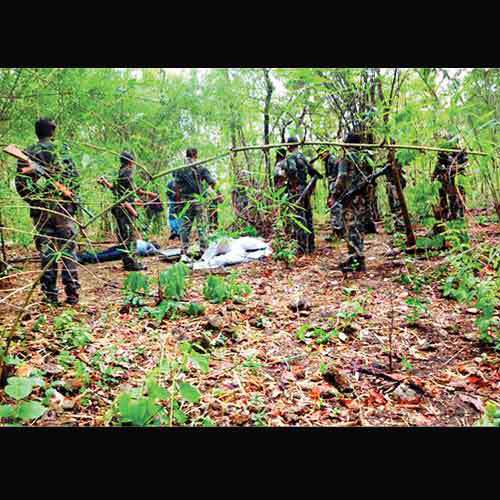[Note: The “Janatana Sarkars” are collective forms of political and economic organization of the adivasis (India’s indigenous peoples) who have organized themselves under the leadership of the Maoists. — Frontlines ed.]
———————————————
Preliminary Report on the Fact Finding In Bijapur District, Chhattisgarh
Democratic Students’ Union, University of Delhi
(Released in a Press Conference at Women’s Press Corps on 15 March 2013)
In the three weeks from mid-January till the first week of February, several villages in the Bijapur District of Chhattisgarh experienced the terror of the armed forces of the Indian state. The CRPF, Chhattisgarh state police, erstwhile SPO’s of the Salwa Judum along with various coercive arms of the state orchestrated a systematic targeting of villages, burnt down hundreds of homes, ostensibly in random, further, burnt down the schools built by the people, picked up villagers, young and old, and physically tortured them while their homes burned to the ground. The affected villages are Pidia, Tomnaka, Singham, Lingham, Komati, Tomudum, and Kondapadu, and in each of these between eight and thirty homes were burnt down by the armed forces. In the village of Dodi-Tumnar, a school with hostel facility for about a hundred children, both girls and boys, run by the Janatana Sarkar was looted and then burnt down by the invading forces in the last week of January. Two battalions of about 1000 CRPF personnel each, besides Koya commandos and SPO’s arrived at the village school at 9 am on that day. They systematically proceeded to destroy the school after firing into the air twice. Even as the students and the schoolmaster fled into the forest, the armed forces caught an old man on his way to the field and chopped off his hand with his own sickle. Following this, the forces looted the storeroom and the kitchen of the school, poisoned the water well, and destroyed the roof, walls, and furniture of the school before finally burning it to the ground. They then marched to the nearby village of Pidia. This village, that houses approximately 265 homes, witnessed first hand the ruthlessness with which the armed force burn down the homes and livelihood of those who stand up for their right to life and liberty. Close to thirty homes were burnt down in one part of this village alone. The charred remains of the homes, cattle sheds, storerooms, utensils can be seen littered with empty bottles of beer and other brands of alcohol. It is clear that this planned attack is part of the routine of military life that participates in wanton destruction and celebrates the impunity they enjoy.

The burial of slain villagers
By burning schools and homes, looting sources of livelihood, and physically torturing hundreds of adivasis, the state attempted to legitimize the violence in the name of ‘development’. This methodical burning of homes and schools reveals the carnival of violence practiced by the forces to intimidate, brutalize and squash the spirit of those living in these parts without any concern for consequences. The villagers were forced to remain in the forest for three days as the force camped in the village as well as the hills surrounding the village. A few young men were picked up by the armed force and brutally beaten. Most of the men were released while one still remains in jail. They looted the means of livelihood and sustenance in the village. Before leaving, they burnt the leftover rations and supplies of the villagers that they had looted. Traces of the violence faced by the village can be seen in the charred remains of homes, shelters, and broken utensils and fences. Here, it is the Janatana Sarkar to whom the villagers turn to in times like these. The Janatana Sarkar provided medicines and food to the affected villagers. It is now also helping them rebuild the burnt homes. Even as the bare frames of the homes are being rebuilt pillar by pillar and brick by brick, the spirit of resistance is visible for all to see. Continue reading →



 One lakh (100,000) men of state police, 40,000 paramilitary fighters and 11 IAF copters fail to make a difference on ground.
One lakh (100,000) men of state police, 40,000 paramilitary fighters and 11 IAF copters fail to make a difference on ground.
